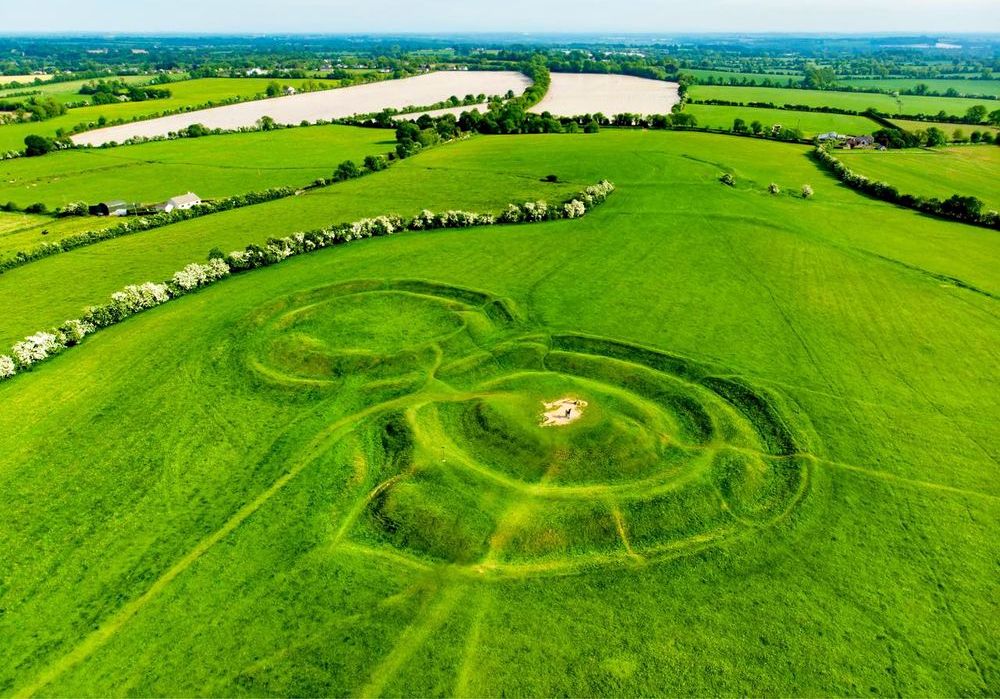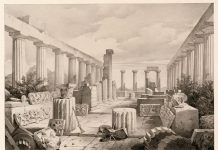One of Ireland’s most important ancient places, the Hill of Tara (in Irish called Cnoc na Teamhrach,Teamhair, or most frequently Teamhair na Rí, Tara of the Kings) can be found less than four kilometres south-east of the River Boyne, between Navan and Dunshaughlin in County Meath. Basically it is a sprawling archaeological complex of ancient earthworks and more refined monuments that is traditionally held to be the seat of theHigh King of Ireland.
And a generally magical, sacred place – though much of this is up to individual belief systems and interpretation of the scarce hard facts that are known about Tara.
At First Glance – That’s Tara?
The first impression most visitors have is a winding, narrow country road, then a car park (often more than crowded), some signs and …
Before Your Road Trip, Watch This
Something very much reminiscent of a slightly unkempt and certainly challenging golf course. With visitors meandering and milling about the place, getting almost lost in a wide expanse of Irish countryside with a few discernible ditches and hillocks here and there. If you came looking for a Hibernian version of Camelot, you might as well leave now. Or just have a coffee.
Tara is more a state of mind than a real, tangible attraction in the sense of (once) huge erections of royal splendour. In fact, the only immediately noticeable ancient erection would be the Lia Fáil. Which, come to think of it, certainly has a phallic symbolism. But is less splendid than more modern monuments to be found on the site.
Being just a stone, after all.
Let us have a look at what you can find on the Hill of Tara, though you will have to explore and walk a bit. Staying in the car park, or even in the churchyard (both are the extreme ends of the prepared pathways) is no option.
The Ancient Monuments of Tara
If you want to explore Tara, you will have to make your (at times slippery, always uneven) way up to the summit of the hill.
From here, it is said at least, you are able to see no less than 25% of the Irish mainland. On a clear day you will believe this, on many another day it’ll seem a very exaggerated claim. But it is not the view we came for, is it?
At the summit you will also find an ovalIron Age hilltop enclosure, a massive hill fortmeasuring no less than 318 metres from north to south, and an impressive 264 metres from east to west. This is surrounded by an internal ditch and an external bank, in military terms as useful as nipples on a breastplate, and an indicator that this was a ceremonial site only. Over the years it became known as the Fort of the Kings (Ráith na Ríogh), or the Royal Enclosure. Within it are further earthworks, a ring fort and a ring barrow with double ditches – they are known as Cormac’s House (Teach Chormaic) and the Royal Seat (Forradh).
Right in the middle of theForradhyou’ll notice a solitary, almost organically formed standing stone. This is believed to be the Stone of Destiny (Lia Fáil), the ancient crowning place of the High Kings. Legend has it that the stone will scream (at a level to be heard all over Ireland) if touched by the rightful king, who also had to meet (and successfully complete) challenges before even being allowed within touching distance.
Just north of this all, but still within the Royal Enclosure, you will also find a rather modestly sized Neolithic passage tomb, this is known as the Mound of the Hostages (Dumha na nGiall). Constructed around 3,400 BCE it has some fine carvings in the short passage, which is said to be oriented towards the rising sun onImbolcandSamhain.
Further north, outside theRáith na Rí, is a ring-fort with no less than three banks, but partially destroyed by the churchyard. This is known as the Rath of the Synods (Ráith na Seanadh). Strangely enough one of the few places in Ireland where Imperial Roman artefacts have been found. Not found here, despite the best efforts of the slightly deludedBritish Israelitesaround 1900, was theArk of the Covenant.
A short distance north again you will just be able to make out a long, narrow, almost rectangular earthwork, almost like a highway leading to Tara. It is commonly called the Banqueting Hall (Teach Miodhchuarta), There is no evidence that there ever was a hall here, so first impressions might be bearer to the truth – it may have been a ceremonial avenue approaching the main site. It certainly feels that way if you walk up the middle of Banqueting Hall, uphill and towards Cormac’s House.
Further earthworks like the Sloping Trenches, Gráinne’s Fort, and Laoghaire’s Fort can be found at the Hill of Tara, all are signposted. As is the Rath Maeve a few hundred metres south, and a Holy Well you pass on the way there. There also is a Wishing Tree, but that is another story.
The Church (and Visitor Centre)
The church on the Hill of Tara, dedicated toSaint Patrick, is far from ancient … and has been allowed to partially destroy the ancient monuments. As it stands today, St. Patrick’s was built in the 1820s, on a site that may have had a church since the 1190s. It once belonged to the Knights Hospitallers of Saint John (Order of Malta in modern parlance), so the theory with the Ark of the Covenant may well have started in medieval times.
History could be said to come full circle – the encroaching Christian church has long been disused, and was then reactivated as a visitor centre byHeritage Ireland.
Here a word of caution is in order: If you google for the Hill of Tara, you may well find many sites that give opening times and an admission fee. Both of these are only relevant to the visitor centre (which is strictly optional, though recommended to quickly brush up on the background of the Hill of Tara). The hill, with all its ancient monuments, is open throughout the year, at any time, even at night.
Actually the best time to visit would be outside the season and outside normal opening hours – I recommend April (when most of the grass is fresh and the ravages of tourism are not that obvious), or early October or November mornings, to catch a sunrise in solitary splendour.
Basic Information on the Hill of Tara
Getting to the Hill of Tara is not complicated – you’ll find the access road (signposted) south of Navan, westwards off the R147 (the old N3, which alsoavoids motorway tolls). If you are coming by motorway, leave the M3 at Junction 7 (signed for Skryne/Johnstown), then turn south onto the R147. The local road approaching the Hill of Tara is narrow and winding, take care here.
Parking is limited at the Hill, expect a bit of manoeuvring, and maybe a short walk.Actually, even getting into the car park might be a problem at busy times – you might have to find a space on the side of the road a bit away. Be careful not to block any entrances to the fields surrounding Tara, and to leave ample room for other traffic to get through. Note that other traffic includes coaches and (more important) large agricultural machinery.
Access to the Hill of Tara is 24/7 through unlocked gates or over stiles.
Take note that the Hill of Tara is a (more or less) natural landscape, absolutely not suitable for wheelchairs or persons with a severe mobility impairment. All others should wear stout shoes with good (gripping) soles, and bring a walking stick if needed.

























